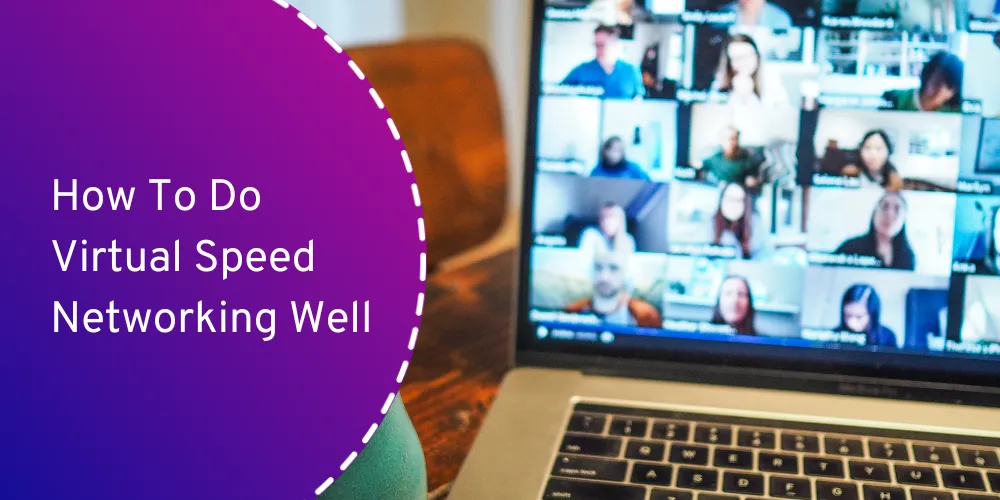Blog

How To Do Virtual Speed Networking Well
Understanding the Basics of Virtual Speed Networking
Virtual speed networking is an innovative evolution of traditional networking, which emerged as a dynamic and efficient adaptation of how professionals connect during the COVID lockdown but is now here to stay. It revolves around brief, structured online meetings, allowing individuals to interact with a diverse range of professionals in a relatively short period. Unlike traditional networking methods that require in-person meetings, virtual networking offers the flexibility to connect from anywhere. This approach to networking is particularly advantageous for those looking to save time, save on fuel costs, and broaden their professional network beyond geographical boundaries.
Common Challenges and How to Overcome Them
While offering many benefits, online networking can present specific challenges you must navigate. One common issue is the potential for technical difficulties like unstable internet connections or audio and video quality issues. To mitigate this, test your equipment and ensure a stable internet connection before the event. Another challenge is the limited time to make an impression or fully understand someone's offerings and needs. Address this by preparing a concise and impactful elevator pitch and actively listening during the short interaction. Managing and organizing the contacts made during these sessions can be overwhelming. Use a CRM system to keep track of new connections and follow-up actions. By anticipating these challenges and preparing accordingly, you can maximize the benefits of virtual networking.
Networking Etiquette in a Virtual Environment
Mastering the nuances of online etiquette is crucial for making a lasting positive impression. The initial interaction in a virtual setting depends on more than just verbal communication; it also involves body language and non-verbal cues. Maintain eye contact by looking into the camera. Nod to show engagement and use facial expressions to convey interest or understanding. These elements are significant in establishing a connection despite not communicating in person. Something else to consider is strict time constraints, which require you to communicate efficiently. A well-prepared introduction and the ability to quickly identify and articulate mutual interests or opportunities for collaboration is critical. Combining clear verbal communication with positive virtual body language and respecting time limits allows you to navigate the virtual networking environment more effectively, which empowers you to leave memorable and favorable impressions on new connections.

Handling Technical Issues with Professionalism
Handling technical issues with professionalism is vital to maintaining the flow and effectiveness of the interactions. Technical glitches are not rare in virtual settings. When it happens, it's essential to stay calm and composed. Know where and how to check your mic or camera settings to quickly resolve the most frequent issues. It would help to have a backup plan, like a pre-written message to inform the other participants. This approach helps mitigate the impact of technical problems and demonstrates adaptability and respect for others' time.
Effective Preparation Strategies for Virtual Speed Networking
Preparation is a cornerstone of successful virtual speed networking. Setting clear goals for each session is fundamental, allowing you to focus your efforts and tailor your interactions to meet specific objectives. Equally important is the preparation of your online profile and presence, as this forms the first impression in the digital world. Update your professional profile on networking platforms and social media. Ensure the information is current, relevant, and reflects your brand and objectives. Also, organize your workspace for optimal engagement. Create a quiet, well-lit environment that minimizes distractions, and make sure the background is professional. These strategies create a conducive environment for effective and fruitful virtual networking, enabling you to present yourself professionally and engage meaningfully with your connections.
Researching Potential Contacts and Companies
Researching potential contacts and companies is a powerful strategy for maximizing the effectiveness of networking online. This approach involves gathering information about the individuals and organizations likely to be encountered during the networking event. By reviewing their profiles on professional platforms like LinkedIn or their company websites, you can gain insights into their professional background, current roles, industry involvement, and areas of expertise. This research helps in identifying common interests or points of synergy. It also enables the formulation of tailored questions and conversation starters. Ensure efficient use of the limited time during a speed networking session. Help foster meaningful connections and open doors to future collaborations or business opportunities.
Crafting an Engaging Elevator Pitch
Crafting an engaging elevator pitch is an art that combines brevity, clarity, and relevance and is essential for making a lasting impact in the fast-paced environment of speed networking. The critical elements of a successful elevator pitch include a clear introduction of yourself and your professional background, a concise overview of what you do, and the unique value or solutions you offer. The effectiveness of an elevator pitch increases with practice and refinement - pay attention to training. A well-crafted elevator pitch can be a powerful tool in making a memorable first impression.

Using Storytelling to Make Your Pitch Memorable
Incorporating storytelling into your elevator pitch can enhance memorability and impact significantly. Storytelling involves weaving a narrative that connects your professional experiences or offerings to a relatable context. This technique helps transform your pitch from merely reciting facts into engaging stories that resonate with the listener. This approach makes your pitch more exciting and helps it stand out in the minds of your audience, who will be hearing numerous pitches in quick succession. A story-driven pitch can spark conversations and open opportunities for deeper engagement, laying the groundwork for more meaningful professional relationships.
Mastering the Art of Virtual Communication
Your improvement in the art of communication in the virtual space is essential in today's digitally connected professional world. Active listening plays a pivotal role in this environment; it involves fully concentrating on the speaker, understanding their message, responding thoughtfully, and remembering key conversation points. Managing conversations is another crucial aspect, especially given the time constraints of speed networking. Learn to steer the discussion mutually beneficially, keeping it on track and tactfully redirecting the focus when necessary. Furthermore, express your thoughts and ideas effectively without unnecessary elaboration. Use simple language and avoid jargon that might confuse the listener. By combining active listening with efficient conversation management and clarity in communication, you can navigate virtual networking sessions more effectively.
Choosing the Right Words for Online Interactions
Choosing the right words for online interactions is a critical skill that can significantly influence the effectiveness and outcome of these digital encounters. The language used in a virtual setting should be professional yet approachable. Since non-verbal cues are less apparent in virtual interactions, the words chosen carry additional weight in conveying tone and intent. Positive phrasing and an encouraging tone help create a welcoming and engaging atmosphere. Phrases that express interest in the other person's work acknowledge their achievements, or invite further discussion can open doors to more fruitful interactions. By selecting words and phrases appropriate for the virtual networking context, you can build rapport, convey professionalism, and lay the groundwork for successful professional relationships.
Follow-Up: Turning Brief Interactions into Lasting Connections
Turning brief interactions into lasting connections requires a thoughtful and strategic follow-up approach. Promptness and relevance are the cornerstones of effective follow-up; reaching out soon after the initial meeting shows genuine interest and helps keep the connection fresh. Personalization plays a crucial role in this process; tailoring follow-up messages to reflect specific details from the conversation demonstrates attentiveness and a genuine interest in the other person's work or challenges. Mention a particular topic discussed, reference a shared interest, or offer resources and assistance relevant to their needs. Building long-term relationships goes beyond a single follow-up message; it involves consistent and meaningful engagement. Regularly share pertinent articles, invite them to relevant events, or check in periodically to discuss industry developments.
Tools for Managing and Organizing Contacts
Effective management and organization of contacts is crucial for capitalizing on these new connections. Utilizing the right tools can significantly streamline this process. Contact management software or Customer Relationship Management (CRM) systems are invaluable in this regard, as they allow for the systematic recording of contact details, conversation notes, and follow-up reminders. These tools often provide features to categorize contacts into groups, making it easier to tailor communication strategies for different types of connections. Many systems integrate with email and social media platforms, enabling seamless communication and contact engagement. Digital business card apps can also be beneficial, allowing for the easy exchange and storage of contact information during virtual meetings. By leveraging these digital tools, you can efficiently manage your growing network.
Leveraging Technology for Enhanced Networking Experience
Leveraging technology is pivotal in enhancing the networking experience, particularly in a virtual environment. Social media platforms are critical, as they offer an extended reach beyond traditional networking boundaries. Platforms like LinkedIn, Twitter, and industry-specific forums allow you to connect with a broader and more diverse audience, participate in discussions, and share insights, increasing your visibility and influence in your respective field. Additionally, networking data analysis plays a significant role in continuous improvement. By reviewing metrics such as response rates, interaction frequency, and the growth of your network, you can gain valuable insights into the effectiveness of your networking strategies and identify areas for enhancement. This data-driven approach enables the refinement of techniques and approaches, ensuring that networking efforts are efficient and fruitful in the long term.
Innovative Networking Platforms and Tools
Innovative networking platforms and tools have revolutionized virtual speed networking, making it more accessible and practical. These platforms are designed to simulate the experience of in-person networking in a digital environment. They often feature user-friendly interfaces that allow easy scheduling and conducting brief, timed one-on-one video meetings, mimicking traditional speed networking events' rapid and dynamic nature. Some platforms also incorporate advanced algorithms for matchmaking, which helps connect participants with the most relevant contacts based on their professional interests, goals, and backgrounds. Many of these tools include integrated features such as instant messaging, file sharing, and digital business card exchanges, facilitating seamless interaction and information exchange during the networking sessions. Furthermore, some platforms offer analytics and tracking features, enabling users to monitor their networking activities and evaluate their success. These innovative tools streamline the networking process and expand the scope and reach of professional networking by connecting individuals across different geographies and industries, thus opening up a more comprehensive array of networking opportunities.
Measuring Success and Learning from Each Virtual Networking Session
Measuring success and learning from each virtual networking session is critical to continuous improvement in professional networking. Setting and regularly evaluating Key Performance Indicators (KPIs) is essential to this process. These KPIs could include the number of meaningful connections made, the frequency of follow-up communications, or the conversion rate of contacts into business opportunities. Tracking these metrics provides tangible benchmarks to assess the effectiveness of networking efforts.
Gathering and Interpreting Qualitative Feedback is Equally Important.
This can involve soliciting direct input from networking contacts or reflecting on the quality of interactions and areas where conversations could have been more engaging or productive. Such insights are invaluable in fine-tuning communication skills and networking strategies.
Adapting strategies for future events becomes crucial based on the analysis of KPIs and feedback.
This might mean refining the elevator pitch, altering the approach to selecting and engaging with contacts, or experimenting with different virtual platforms to find the most suitable one. Continually adapting and evolving these strategies based on measured outcomes and feedback ensures ongoing improvement and effectiveness in virtual networking endeavors.
Learning from Networking Successes and Failures
Learning from successes and failures is crucial for personal and professional growth. Successes in networking provide insights into what strategies and approaches work well. Analyzing these successful interactions helps understand the elements that contributed to their effectiveness, such as a well-crafted pitch, the ability to listen actively, or the aptitude to ask insightful questions. On the other hand, reflecting on failures or less successful interactions is equally important. These instances, where connections might not have materialized as hoped, or conversations did not go as planned, offer opportunities for critical self-assessment and learning.
Understanding the Reasons Behind Shortcomings
Whether your shortcomings relate to technical issues, communication missteps, or inadequate preparation – it is critical to avoid similar pitfalls in the future. By taking a balanced approach to evaluating both successes and failures in virtual networking, you can continually refine your networking skills, adapt your strategies, and enhance your ability to make meaningful professional connections in a digital environment.
In Conclusion: Master Virtual Speed Networking
Understand the basics of virtual speed networking, such as embracing flexibility and overcoming common challenges, mastering online etiquette, and preparing effectively for each session. Craft an engaging elevator pitch, use storytelling to make your pitch memorable, and practice your virtual communication skills. Follow-up strategies are necessary for building lasting connections, so using the tools for managing and organizing contacts helps you with this. Leveraging technology, such as innovative networking platforms and CRM systems, enhances the overall networking experience. Measuring success and learning from each session is best for continuous improvement. By applying these strategies, you can confidently navigate the virtual networking landscape.
Copyright © 2017-2025 Raise Your Media I Privacy Policy
We believe that every small business deserves simple and effective sales and marketing tools.


